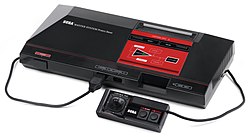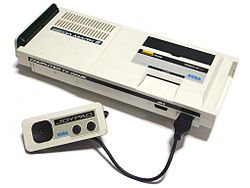
Back Master System AN سيجا ماستر سيستم Arabic سيجا ماستر سيستم ARZ Master System AST Sega Master System Bulgarian Sega Master System Breton Sega Master System Catalan Sega Master System Czech Sega Master System Danish Sega Master System German
 | |
| |
| Developer | Sega |
|---|---|
| Manufacturer | Sega |
| Type | Home video game console |
| Generation | Third |
| Release date | |
| Lifespan | |
| Introductory price | ¥16,800 (equivalent to ¥20,000 in 2019) US$200 (equivalent to $560 in 2023) £99.95 (equivalent to £360 in 2023) |
| Units sold | 10-13 million[9][10][a] |
| Media | ROM cartridge, Sega Card |
| CPU | Zilog Z80 @ 3.58 MHz (NTSC) |
| Memory | 8 KB RAM 16 KB VRAM |
| Display | 256 × 192 resolution, 32 colors on-screen |
| Sound | Texas Instruments SN76489 PSG via VDP Yamaha YM2413[b] |
| Backward compatibility | SG-1000[b] |
| Predecessor | SG-1000[b] |
| Successor | Sega Genesis |
| Related | Game Gear |
The Master System[c] is an 8-bit third-generation home video game console manufactured and developed by Sega. It was originally a remodeled export version of the Sega Mark III, the third iteration of the SG-1000 series of consoles, which was released in Japan in 1985 with improved graphical capabilities compared to its predecessors. The Master System launched in North America in 1986, followed by Europe in 1987, and then in Brazil and Korea in 1989. A Japanese version of the Master System was also launched in 1987, which features a few enhancements over the export models (and by proxy the original Mark III): a built-in FM audio chip, a rapid-fire switch, and a dedicated port for the 3D glasses. The Master System II, a cheaper model, was released in 1990 in North America, Australasia and Europe.
The original Master System models use both cartridges and a credit card-sized format known as Sega Cards. Accessories include a light gun and 3D glasses that work with specially designed games. The later Master System II redesign removed the card slot, turning it into a strictly cartridge-only system, and is incompatible with the 3D glasses.
The Master System was released in competition with the Nintendo Entertainment System (NES). Its library is smaller and with fewer well-reviewed games than the NES, due in part to Nintendo licensing policies requiring platform exclusivity. Though the Master System had newer, improved hardware, it failed to overturn Nintendo's significant market share advantage in Japan and North America. However, it attained significantly greater success in other markets, including Europe, Brazil, South Korea and Australia.
The Master System is estimated to have sold between 10-13 million units worldwide. In addition, Tectoy has sold 8 million licensed Master System variants in Brazil. Retrospective criticism has recognized its role in the development of the Sega Genesis, and a number of well-received games, particularly in PAL (including PAL-M) regions, but is critical of its limited library in the NTSC regions, which were dominated by the NES.
- ^ Cite error: The named reference
CEwas invoked but never defined (see the help page). - ^ Cite error: The named reference
MK3was invoked but never defined (see the help page). - ^ a b Gamers High! Futabasha Super Mook (in Japanese). Futabasha. 2015. p. 55. ISBN 978-4-575-45554-0.
- ^ Cite error: The named reference
MSwas invoked but never defined (see the help page). - ^ "家庭用 컴퓨터 시판". 매일경제. October 13, 1988. Retrieved September 21, 2022.
- ^ Cite error: The named reference
Korea1was invoked but never defined (see the help page). - ^ "Parabéns Master System!! (Wayback Machine: 2012-03-23 13:53)". Tectoy. September 4, 2009. Archived from the original on March 23, 2012. Retrieved September 21, 2022.
- ^ "The SEGA Master System in Brazil: History of a Forgotten Video Game Console". Munib Rezaie: Media Blog and Academic Portfolio. January 25, 2022. Archived from the original on September 22, 2022. Retrieved September 21, 2022.
- ^ Forster, Winnie (2005). The Encyclopedia of Game Machines: Consoles, Handhelds, and Home Computers 1972–2005. Magdalena Gniatczynska. p. 139. ISBN 3-00-015359-4.
- ^ Cite error: The named reference
GENSNESwas invoked but never defined (see the help page). - ^ Cite error: The named reference
business_japanwas invoked but never defined (see the help page). - ^ Cite error: The named reference
sheff_1993was invoked but never defined (see the help page). - ^ Cite error: The named reference
digest_60was invoked but never defined (see the help page). - ^ Cite error: The named reference
Koreawas invoked but never defined (see the help page). - ^ Cite error: The named reference
Sega MegaZonewas invoked but never defined (see the help page). - ^ Cite error: The named reference
MDBwas invoked but never defined (see the help page).
Cite error: There are <ref group=lower-alpha> tags or {{efn}} templates on this page, but the references will not show without a {{reflist|group=lower-alpha}} template or {{notelist}} template (see the help page).


